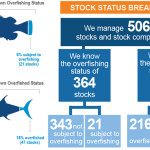U.S. shoppers are spending more on groceries this year as they balance their desire for quality and healthiness with the higher cost of food, including seafood, according to two new surveys.
Besides cost, American consumers are also considering eating well, quality, nutrition, freshness, convenience, family food preferences, individual cooking skills and habits, and individual shopping experiences when deciding whether to purchase a particular food product, according to the Food Industry Association (FMI) Vice President of Research and Insights Steve Markenson. Health attributes, quality, and sustainability are also factors in seafood-purchasing decisions being made by U.S. consumers in 2023, Markenson said.
“It is much more complex, where the lowest price isn’t necessarily the king,” he said.
FMI’s 2023 Grocery Shopper Trends report, which was based off a survey of 2,000 consumers conducted in February 2023 in partnership with the Hartman Group, revealed the rising cost of food ranks at the top of shoppers’ economic concerns, with 75 percent saying they are more concerned about that than the price of gas (69 percent), food from restaurants (55 percent), rent and housing (44 percent), and clothing (44 percent), FMI stated.
The survey found 68 percent of shoppers said they are spending more on groceries now than they did a year ago, Markenson said. Despite high inflation, most shoppers are not completely eliminating food categories that are important to them.
“[Shoppers] have gotten very savvy, very flexible, very creative, and also very prudent when it comes to their food purchases,” he said. “They are being very smart by looking for deals, they are shopping at multiple stores, they are looking online to compare prices, and they are buying more private brand products than ever before.”
Americans are buying more frozen seafood, Markenson said, referring to a critical finding of FMI’s 2023 Power of Seafood report.
“With frozen seafood, you can just pull out what you want and keep the other fresh for an extended period of time,” Markenson
Shoppers are also getting more creative with their seafood purchases.
“Instead of [simply] having a salmon meal, it may be a stir fry with shrimp and rice,” he said. “They are spreading their food dollars.”
Americans still like seafood because they believe it healthier for them, more sustainable than other proteins, packs a protein punch, and is fun to cook at home, Hartman Group CEO Laurie Demeritt said.
“Even though seafood is thought of by consumers as more expensive, they might try a less-expensive part of the fish or buy another fish,” she said.
To save money, consumers are shopping more at …
Photo courtesy of ungvar/Shutterstock








